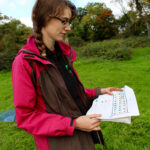Mae gennyf ddiddordeb mewn cadwraeth planhigion a pheillwyr, ac mewn archwilio’r rhyngweithiadau rhyngddynt. Roedd fy ymchwil PhD gyda Gardd Fotaneg Genedlaethol Cymru a Phrifysgol Bangor yn archwilio dewisiadau chwilota gwenyn mêl gan ddefnyddio codau metabar DNA, ac yn edrych ar newidiadau chwilota ar lefel y dirwedd. Rwy’n cyfrannu at feysydd ymchwil parhaus yr Ardd Fotaneg, gan gynorthwyo’r tîm i gynnal hyfforddiant labordy a dadansoddi data.
Jones L., Lowe A., Ford C.R., Christie L., Creer S., de Vere N., (2022). Temporal Patterns of Honeybee Foraging in a Diverse Floral Landscape Revealed Using Pollen DNA Metabarcoding of Honey, Integrative and Comparative Biology. icac029.
Lowe A., Jones L., Witter L., Creer S., de Vere N. (2022). Using DNA Metabarcoding to Identify Floral Visitation by Pollinators. Diversity 14:236.
Lowe A, Jones L, Brennan G, Creer S., de Vere N. (2022). Seasonal progression and differences in major floral resource use by bees and hoverflies in a diverse horticultural and agricultural landscape revealed by DNA metabarcoding. Journal of Applied Ecology.
Henniges MC, Powell RF, Mian S, Stace CA, Walker KJ, Gornall RJ, Christenhusz MJM, Brown MR, Twyford AD, Hollingsworth PM, Jones L, de Vere N, Antonelli A, Leitch AR, Leitch IJ. (2022). A taxonomic, genetic and ecological data resource for the vascular plants of Britain and Ireland. Scientific Data 9:1.
Moughan, J., McGinn, K.J., Jones, L., Rich, T.C.G., Waters, E., de Vere, N., (2021). Biological Flora of the British Isles: Salvia pratensis. Journal of Ecology 1–20.
Jones, L., Twyford, A.D., Ford, C.R., Rich, T.C.G., Davies, H., Forrest, L.L., Hart, M.L., McHaffie, H., Brown, M.R., Hollingsworth, P.M., de Vere, N., (2021). Barcode UK: A complete DNA barcoding resource for the flowering plants and conifers of the United Kingdom. Molecular Ecology Resources 1–13.
Jones, L., Brennan, G.L., Lowe, A., Creer, S., Ford, C.R., de Vere, N., (2021). Shifts in honeybee foraging reveal historical changes in floral resources. Communications Biology 4, 37.
Brennan, G.L., Potter, C., de Vere, N., Griffith, G.W., Skjøth, C.A., Osborne, N.J., Wheeler, B.W., McInnes, R.N., Clewlow, Y., Barber, A., Hanlon, H.M., Hegarty, M., Jones, L., Kurganskiy, A., Rowney, F.M., Armitage, C., Adams-Groom, B., Ford, C.R., Petch, G.M., Creer, S., (2019). Temperate airborne grass pollen defined by spatio-temporal shifts in community composition. Nature Ecology & Evolution 3.
Potter, C., de Vere, N., Jones, L., Ford, C.R., Hegarty, M.J., Hodder, K.H., Diaz, A., Franklin, E.L., (2019). Pollen metabarcoding reveals broad and species-specific resource use by urban bees. PeerJ 7.
Lucas, A., Bodger, O., Brosi, B. J., Ford, C. R., Forman, D. W., Greig, C., Hegarty, M., Jones, L., Neyland, P. J. & de Vere, N. (2018) Floral resource partitioning by individuals within generalised hoverfly pollination networks revealed by DNA metabarcoding. Scientific Reports, 8, 5133.
de Vere N, Jones L, Gilmore T, Moscrop J, Lowe A, Smith D, Hegarty M, Creer S, Ford CR (2017) Using DNA metabarcoding to investigate honey bee foraging reveals limited flower use despite high floral availability. Scientific Reports 7, 42838.
